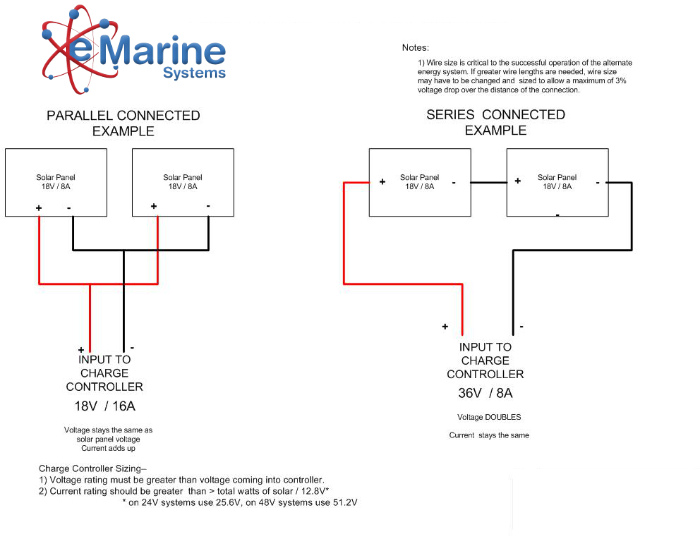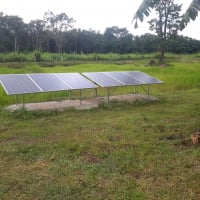van electrical wire gauge help!
AngeW
Registered Users Posts: 4 ✭
Would appreciate any input on my electrical wiring for my van. Especially concerned if i have the proper wire gauges selected! Schematic sketch attached. Thank You!
Comments
-
I don't see your suplimental source of power. You are likely going to be short with a fridge which runs 24/7. I would hard wire this, 50 watts is a lot to run through a cigarette plug.AngeW said:Would appreciate any input on my electrical wiring for my van. Especially concerned if i have the proper wire gauges selected! Schematic sketch attached. Thank You!
You can look to your inverter manual for the wire gauge for it, a 1500 watt 12 volt should need a wire capable of running the max load, something like 1500/11.5=130amps.
Your charge controller isn't spec'd as being MPPT type, if it's a PWM you should have the panels in parallel.
Home system 4000 watt (Evergreen) array standing, with 2 Midnite Classic Lites, Midnite E-panel, Magnum MS4024, Prosine 1800(now backup) and Exeltech 1100(former backup...lol), 660 ah 24v Forklift battery(now 10 years old). Off grid for 20 years (if I include 8 months on a bicycle).
- Assorted other systems, pieces and to many panels in the closet to not do more projects. -
There are some issues that need to be addressed, the battery is fused at the fuse block with a 200 A fuse, then the inverter is connected via a 300A fuse which is redundant because the 200 A would protect the 300 A. The inverter should be connected directly to the battery with a fuse or circuit breaker as close to the battery as possible, a secondary wire of smaller gauge, also with appropriate fuse/breaker could be used to feed the fuse block.
The NEC current rating for 90°C #2 awg is ~130 A but will carry significantly more particularly if the run distance is extremely short, something not indicated, 300 A is too high, a 175 A would be more appropriate, this would handle 1500 W rating of the inverter at minimum voltage The sole purpose of the fuse / breaker is to protect the conductors downstream of it hence the importance of placing them close to the energy source, batteries can provide extremely high current in the hundreds or thousands of amps in short circuit.
1500W, 6× Schutten 250W Poly panels , Schneider MPPT 60 150 CC, Schneider SW 2524 inverter, 400Ah LFP 24V nominal battery with Battery Bodyguard BMS
Second system 1890W 3 × 300W No name brand poly, 3×330 Sunsolar Poly panels, Morningstar TS 60 PWM controller, no name 2000W inverter 400Ah LFP 24V nominal battery with Daly BMS, used for water pumping and day time air conditioning.
5Kw Yanmar clone single cylinder air cooled diesel generator for rare emergency charging and welding. -
thanks! Fridge is a 12v camper fridge, peaks at 7.5 amps.Photowhit said:
I don't see your suplimental source of power. You are likely going to be short with a fridge which runs 24/7. I would hard wire this, 50 watts is a lot to run through a cigarette plug.AngeW said:Would appreciate any input on my electrical wiring for my van. Especially concerned if i have the proper wire gauges selected! Schematic sketch attached. Thank You!
You can look to your inverter manual for the wire gauge for it, a 1500 watt 12 volt should need a wire capable of running the max load, something like 1500/11.5=130amps.
Your charge controller isn't spec'd as being MPPT type, if it's a PWM you should have the panels in parallel.
for the inverter i will size down the fuse, originally sized it to the max surge but that isnt necessary.
Charge controller is PWM. -
Thanks!mcgivor said:There are some issues that need to be addressed, the battery is fused at the fuse block with a 200 A fuse, then the inverter is connected via a 300A fuse which is redundant because the 200 A would protect the 300 A. The inverter should be connected directly to the battery with a fuse or circuit breaker as close to the battery as possible, a secondary wire of smaller gauge, also with appropriate fuse/breaker could be used to feed the fuse block.
The NEC current rating for 90°C #2 awg is ~130 A but will carry significantly more particularly if the run distance is extremely short, something not indicated, 300 A is too high, a 175 A would be more appropriate, this would handle 1500 W rating of the inverter at minimum voltage The sole purpose of the fuse / breaker is to protect the conductors downstream of it hence the importance of placing them close to the energy source, batteries can provide extremely high current in the hundreds or thousands of amps in short circuit.
So you suggest a 200A fuse at battery from fuse box and 175 fuse at battery from inverter? -
Also the charge controller, inverter and batteries are all within a couple feet of each other.
-
My suggestion was to use a 175 A fuse / breaker at the battery to power the inverter, if using #2 awg, then use a second fuse / breaker at the battery to feed the fuse block. The capacity of the secondary protection should correspond to the gauge of conductors feeding the fuse block, which will be less since the inverter has its independent feed, the loads powered by the fuse block, along with the fuse block's actual maximum capacity will determine the size of all said equipment.AngeW said:
Thanks!mcgivor said:There are some issues that need to be addressed, the battery is fused at the fuse block with a 200 A fuse, then the inverter is connected via a 300A fuse which is redundant because the 200 A would protect the 300 A. The inverter should be connected directly to the battery with a fuse or circuit breaker as close to the battery as possible, a secondary wire of smaller gauge, also with appropriate fuse/breaker could be used to feed the fuse block.
The NEC current rating for 90°C #2 awg is ~130 A but will carry significantly more particularly if the run distance is extremely short, something not indicated, 300 A is too high, a 175 A would be more appropriate, this would handle 1500 W rating of the inverter at minimum voltage The sole purpose of the fuse / breaker is to protect the conductors downstream of it hence the importance of placing them close to the energy source, batteries can provide extremely high current in the hundreds or thousands of amps in short circuit.
So you suggest a 200A fuse at battery from fuse box and 175 fuse at battery from inverter?
Being limited to vague outlines regarding the capacity limitations of the fuse block, only vague and limited information can be provided or suggested, details are so important.1500W, 6× Schutten 250W Poly panels , Schneider MPPT 60 150 CC, Schneider SW 2524 inverter, 400Ah LFP 24V nominal battery with Battery Bodyguard BMS
Second system 1890W 3 × 300W No name brand poly, 3×330 Sunsolar Poly panels, Morningstar TS 60 PWM controller, no name 2000W inverter 400Ah LFP 24V nominal battery with Daly BMS, used for water pumping and day time air conditioning.
5Kw Yanmar clone single cylinder air cooled diesel generator for rare emergency charging and welding. -
An ~200 Amp 12 volt fuse/breaker is pretty large for a 200 AH @ 12 volt (AGM) and 200 Watt solar array--And a 1,500 Watt AC inverter...
More or less (always read the manual) a 1,500 Watt @ 12 volt inverter would use a fuse/breaker/wiring rated at:- 1,500 Watts * 1/0.85 AC inverter eff * 1/10.5 battery cutoff voltage = 168 Amps minimum
- 168 Amps * 1.25 NEC derating for continuous loads = 210 Amps "nominal" conservative block
You do need to look at your AC loads... For a "cabin" / small off grid system... As an example, say you want 5 hours a night for 2 nights and 50% max planned discharge (for longer battery life, and allow for a day of poor sun). That is 5+5+10=20 hour discharge rate...- 200 AH / 20 hours = 10 amps average loads (DC)
- 200 AH * 1/20 hours * 12 volts * 0.85 AC inverter eff = 102 Watt average load (120 VAC)
And for charging--200 Watts of solar will take a lot of sun to recharge the bank. Depending on where you will be, seasons, if you tilt the array to the sun, etc.--A good summer harvest for a flat array of around 4 hours of sun per day:- 200 Watts * 0.59 off grid AC+AGM system efficiency * 4 hours of good sun = 472 Watt*Hours of 120 VAC per day average harvest
- 200 Watts * 0.69 off grid DC+AGM system efficiency * 4 hours of good sun = 552 Watt*Hours of 12 VDC per day
- 552 WH of DC / 12 VDC = 46 AH per day of 12 VDC energy
-BillNear San Francisco California: 3.5kWatt Grid Tied Solar power system+small backup genset -
So you need to wire your panels in parallel, NOT in series as shown.AngeW said:
Charge controller is PWM.Photowhit said:
Your charge controller isn't spec'd as being MPPT type, if it's a PWM you should have the panels in parallel.AngeW said:Would appreciate any input on my electrical wiring for my van. Especially concerned if i have the proper wire gauges selected! Schematic sketch attached. Thank You!
Please look at the type of fridge. It sounds like a thermal electric fridge, which is on all the time. a 50 watt continuous draw is a lot of energy!AngeW said:
Fridge is a 12v camper fridge, peaks at 7.5 amps.Photowhit said:
I don't see your suplimental source of power. You are likely going to be short with a fridge which runs 24/7. I would hard wire this, 50 watts is a lot to run through a cigarette plug.AngeW said:Would appreciate any input on my electrical wiring for my van. Especially concerned if i have the proper wire gauges selected! Schematic sketch attached. Thank You!
50x24 hours a day = 1200watts. 4 amps x 24 hours is roughly half you battery capacity. 1 cloudy day could put you in serious negative numbers.
Home system 4000 watt (Evergreen) array standing, with 2 Midnite Classic Lites, Midnite E-panel, Magnum MS4024, Prosine 1800(now backup) and Exeltech 1100(former backup...lol), 660 ah 24v Forklift battery(now 10 years old). Off grid for 20 years (if I include 8 months on a bicycle).
- Assorted other systems, pieces and to many panels in the closet to not do more projects.
Categories
- All Categories
- 233 Forum & Website
- 141 Solar Forum News and Announcements
- 1.4K Solar News, Reviews, & Product Announcements
- 199 Solar Information links & sources, event announcements
- 900 Solar Product Reviews & Opinions
- 256 Solar Skeptics, Hype, & Scams Corner
- 22.5K Solar Electric Power, Wind Power & Balance of System
- 3.5K General Solar Power Topics
- 6.7K Solar Beginners Corner
- 1K PV Installers Forum - NEC, Wiring, Installation
- 2.1K Advanced Solar Electric Technical Forum
- 5.6K Off Grid Solar & Battery Systems
- 429 Caravan, Recreational Vehicle, and Marine Power Systems
- 1.1K Grid Tie and Grid Interactive Systems
- 656 Solar Water Pumping
- 816 Wind Power Generation
- 624 Energy Use & Conservation
- 623 Discussion Forums/Café
- 315 In the Weeds--Member's Choice
- 75 Construction
- 125 New Battery Technologies
- 108 Old Battery Tech Discussions
- 3.8K Solar News - Automatic Feed
- 3.8K Solar Energy News RSS Feed

